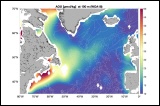Ventilation
Long-term ventilation changes of Subpolar Mode Waters in the North Atlantic Ocean and its impact on the oxygen distribution
Funding: DFG
Period: 2020 - 2025
|
|
Ocean ventilation is a process that transfers properties, such as oxygen and carbon dioxide from the surface into the ocean interior where they are propagating following mainly the circulation pathways. In a warming ocean as a result of climate change, density stratification increases leading to reduced ventilation and loss of oxygen, particularly in the subpolar region. In the subpolar North Atlantic Ocean, Subpolar Mode Waters (SPMWs) are formed during late winter convection following the cyclonic circulation of the subpolar gyre. They participate in the upper flow of the Atlantic overturning circulation (AMOC) and provide much of the water that is eventually transformed into several components of the North Atlantic Deep Water (NADW), the cold, deep part of the AMOC. Thus, understanding how these water masses are affected by ventilation changes will help us to better understand the variability in the AMOC. |
|
|
The objectives of this proposal are: 1) investigate the effect of ventilation changes on the formation of SPMWs and on the volume occupied by these water masses over the last five decades, 2) investigate the long-term variability of SPMW properties with a particular focus on the oxygen variability, 3) evaluate the relationship within the SPMW with respect to changing ventilation ages and oxygen utilization rate (OUR) to better distinguish between the three main mechanisms driving the oxygen changes in the ocean: air-sea gas exchanges, circulation and marine biology and utilize the output of a high resolution model to analyse the mechanisms driving the observed changes. |

(click to enlarge)
|
|
printer friendly page |
(C) 2019 - All rights reserved